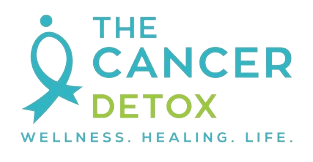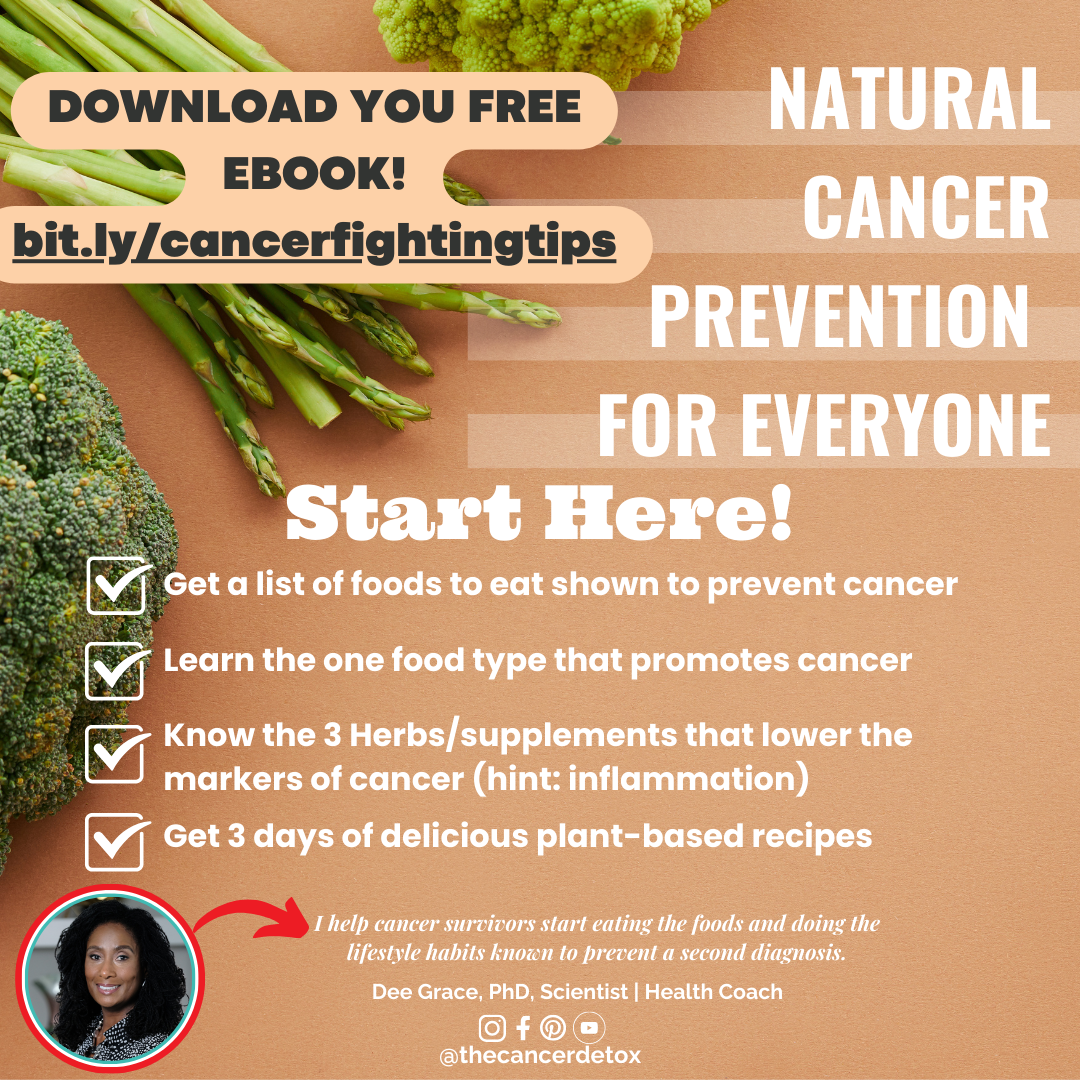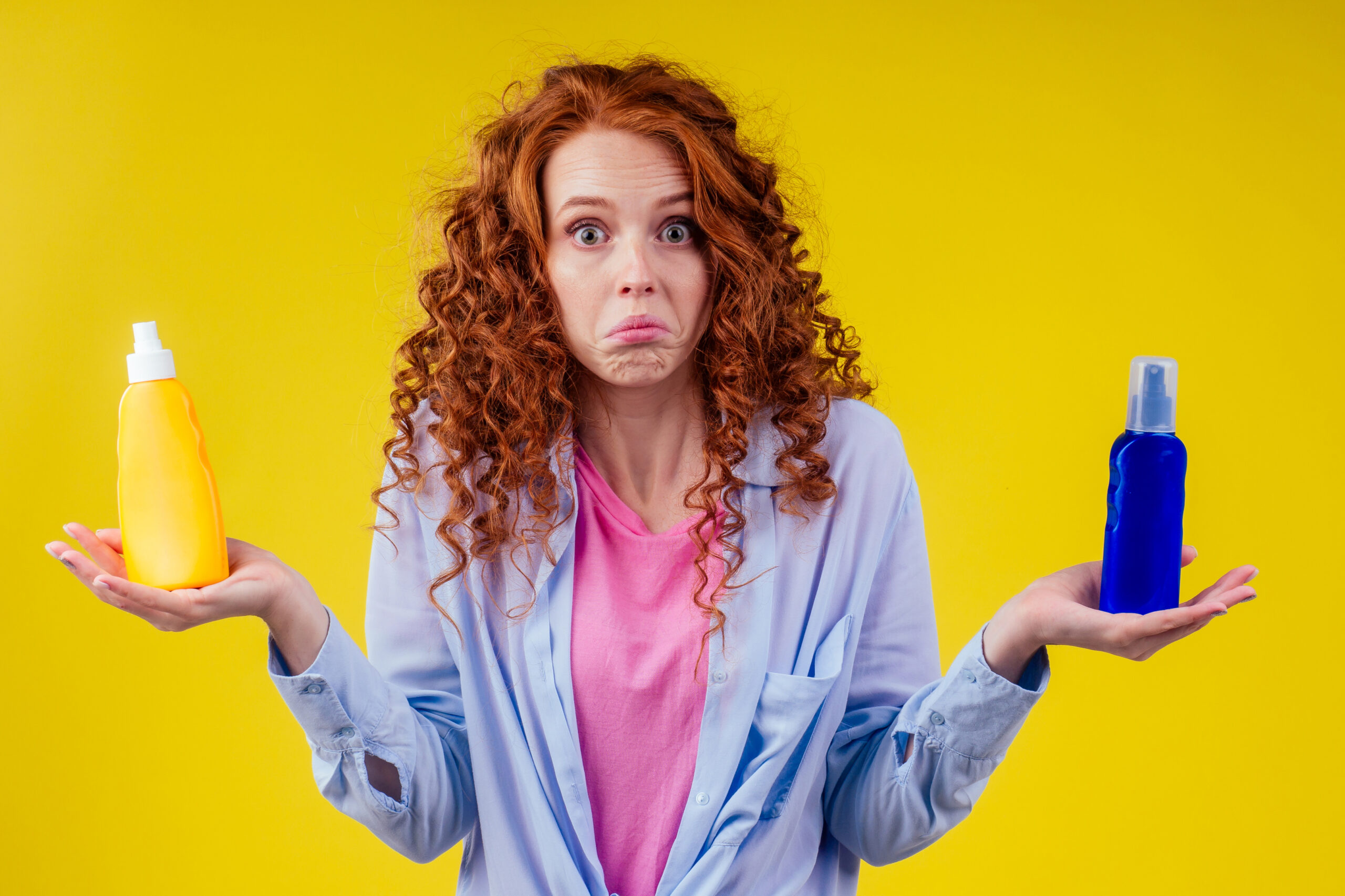
7 Natural Sunscreens + 5 Plant-Based Foods that Work as “Internal” Sunscreens (Self Care Corner)
Every now and again we discuss self-care strategies that benefit health, so in honor of summer, this article will dive into 7 natural sunscreen alternatives that do not contain typical toxic ingredients found in traditional sunscreens, plus 5 plant-based foods that work as “internal” sunscreens.
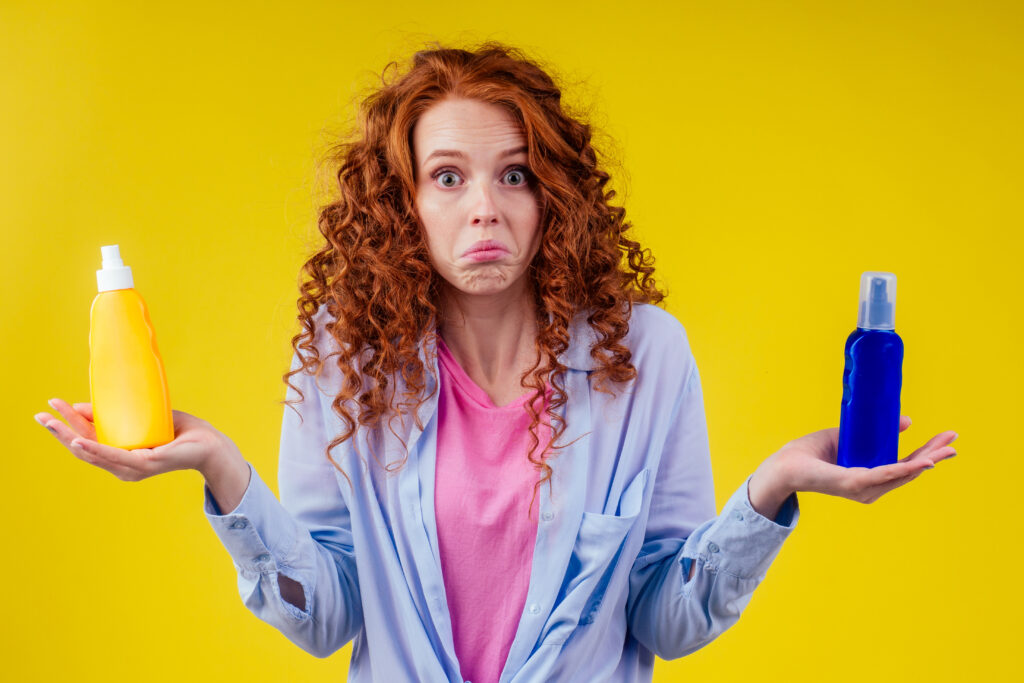
Sunscreen endocrine disruptors
INTRODUCTION
Holistic sunscreens are all the rage, and rightly so! Traditional sunscreen ingredients contain harmful ingredients (e.g., oxybenzone, octinoxate, 4-methylbenzylidene camphor) that can harm fish, coral reefs, and other aquatic organisms. These sunscreen ingredients also harm humans as they disrupt the normal functioning of the body’s hormones (i.e., endocrine disruptors). The most widely used active ingredient found in sunscreens is oxybenzone, which is used in hundreds of sunscreen products. It is an effective sunscreen, as it absorbs ultraviolet (UV) light known as UV-A rays (320 – 400 nm) and UV-B rays (290 – 320 nm), however its damaging effects have been reported in the scientific literature for years.
IN THIS ARTICLE, YOU WILL LEARN:
- 7 natural sunscreen alternatives
- The one flower from the Alpine mountains that not only protects from sun damage, but reverses it
- 4 plant-based products that work internally (and topically) to prevent or reverse sun damage
- Learn about other holistic sun care practices from our previous article
- If you like this info, then sign up for the early-bird list for my NEW BOOK “Cancer Prevention: Diet and Lifestyle Factors that Reduce Your Risk.” Get a 50% discount off regular price during pre-release + an e-Guide on Spirulina for weight loss, heart and eye health
UV RAYS DAMAGE SKIN, NO MATTER THE COLOR
UV light comes in two forms: 1) UV-A rays which cause damage to the skin by penetrating into its deeper layers and forming free radicals (i.e., oxidants), and 2) UV-B rays which causes sunburns. What are free radicals? Well they are tiny particles that are produced in the body. Normal bodily functions, like breathing in air, produce free radicals. They are “bad” for our bodies because they damage our cells, proteins, and DNA. DNA damage is a huge problem that we all must deal with. When cells contain damaged DNA, they begin to grow uncontrollably, leading to tumor growth and cancer development. A body that is overloaded with free radicals is known to have oxidative stress. UV-A rays form free radicals in the skin, leading to DNA damage in skin cells, causing premature aging of the skin, and may ultimately lead to skin cancer development (e.g., basal cell carcinoma, squamous cell carcinoma).
Free radicals are a necessary evil. Because all of us breathe air and go outside to get sun exposure, we are all making free radicals. Luckily the body makes antioxidants (i.e., glutathione, superoxide dismutase), which inactivates free radicals. We can also eat foods high in antioxidants to add an additional supply and help reduce the free radical damage that occurs internally. Eating a diet high in antioxidants benefits the skin, the body’s largest organ.
Below are 7 natural sunscreen alternatives that protect skin from UV-A and UV-B rays and 4 plant-based foods that function as internal sunscreens (and are also great cancer-fighting foods).
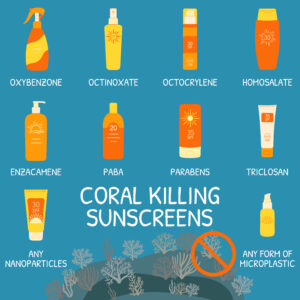
Sunscreen ingredients with endocrine disruptors that kill coral reef
NATURAL SUNSCREEN ALTERNATIVES
Personal care products are a new source of contamination in our oceans, lakes, and streams. Excessive use of traditional sunscreens should be avoided when going into these areas. Fortunately, there are natural sunscreen alternatives to traditional oxybenzone-prepared sunscreens that work well. Natural sunscreens are sun protection products, similar to traditional sunscreens, that use ingredients derived from natural sources instead of synthetic chemicals. These ingredients typically provide a physical barrier on the skin, reflecting or scattering the sun’s UV-A and UV-B rays so that they are not absorbed.
7 Natural Sunscreen Alternatives
1. ZINC OXIDE
This mineral compound provides broad-spectrum protection against both UV-A and UV-B rays. Zinc oxide forms a physical barrier on the skin and is effective at blocking a wide range of the sun’s rays
2. TITANIUM DIOXIDE
Similar to zinc oxide, titanium dioxide is a mineral ingredient that reflects and scatters UV rays. It is often used in combination with zinc oxide in natural sunscreens
A WORD OF CAUTION:
Recent research suggests that natural sunscreens such as zinc oxide and titanium dioxide create unintended toxicity in the skin when worn for more than 2 hours and when they are not reapplied throughout the day. Zinc oxide and other inactive ingredients break down into toxic compounds when exposed to UV light, therefore you must reapply them. As well, the UV-reflecting abilities of zinc oxide drastically decreases, allowing UV rays to contact the skin [1]. (https://www.sciencedaily.com/releases/2021/10/211014100220.htm)
3. RASPBERRY SEED OIL
This has a natural SPF (Sun Protection Factor) of around 30 and is rich in antioxidants. Raspberry seed oil can help protect the skin from sun damage and provides some level of sun protection, however it only blocks UV-B rays and not UV-A rays (which causes free radicals).
4. CARROT SEED OIL
This oil contains carotenoids, specifically, and also well-known, beta carotene. It provides some protection against the sun’s rays. It is often used in conjunction with other natural sunscreen ingredients, such as coconut oil.
5. COCONUT OIL
While coconut oil has a low natural SPF (around 4-6), it can be used as a carrier oil in sunscreen formulations to provide moisturizing and soothing properties to the skin
6. SHEA BUTTER
Shea butter is a natural moisturizer that can also offer a small amount of sun protection due to its natural content of cinnamic acid, which absorbs UVB rays
7. SHINORINE
This is a UV-absorbing substance found in freshwater algae (e.g., cyanobacteria, marine algae) known as the “green” sunscreen. A few products contain shinorine. Look for natural sunscreen products that contain red algae and either zinc oxide or titanium oxide, like Mara’s Sea Kale Sunscreen.
4 PLANT-BASED “INTERNAL” SUNSCREEN ALTERNATIVES
The dictionary defines self-care as “the practice of taking action to preserve or improve one’s own health.” Preserving skin health is vitally important, as it typically contains a high amount of free radicals that damage skin cells that may lead to skin cancer development. When you think about it, the skin has a high amount of free radicals because it is the only organ that is in direct contact with UV rays and environmental pollutants.
Damage from the environment causes up to 80% of skin aging, and only 20% of skin aging is due to the natural, intrinsic process of “getting older.” Highly pigmented skin (e.g., darker skin color) typically has more antioxidants due to higher amounts of melanin (a natural antioxidant), however, premature aging still occurs in those with highly melanated skin.
In addition to UV rays, high levels of oxidative stress (caused by poor diet, environmental toxins, or mental stress) can also increase the amount of free iron in the skin because it disrupts iron homeostasis (i.e., balance). As the levels of oxidative stress increase, the iron balance is disrupted, creating free iron which damages the skin. This free iron can also produce more free radicals, resulting in “one-two” punch to the skin.
Getting older also increases the amount of free iron in the body, particularly in the skin. Post-menopausal women have a more pronounced amount of free iron due to the lack of menstruation (which excretes iron).
Can anything be done to stop this process? Possibly, natural skin care focused on applying common foods and plants that deliver beneficial ingredients (e.g., antioxidants such as vitamins C and E) is quite popular these days and appears to be working. Eating these foods may also provide protection from UV rays “from the inside out.” Diets that are high in antioxidants (e.g., vegetables, fruit, algae) have been shown to protect against skin aging and work as a possible “internal” sunscreen. In fact, a scientist recently said: “…using exogenous AOs [antioxidants from fruits, vegetables, and plants] appears to be a valuable strategy for preventing UV-induced skin photodamage and photoaging.” (https://www.sciencedaily.com/releases/2022/04/220412140903.htm)

Self care quotes
5 PLANT-BASED “INTERNAL” SUNCREENS
1. VITAMIN E
- Obtained from plants, algae, cyanobacteria (e.g., spirulina, chlorella) this antioxidant has been used topically for years as an anti-wrinkle product. Its antioxidant properties are well established, as it scavenges the body for free radicals and inactivates them
2. SPIRULINA
- Spirulina is a blue-green algae that has been shown to benefit cancer patients when consumed during their chemotherapy. When added to standard sunscreens (along with a compound called DMC) it significantly decreased the destruction of collagen and reduced skin pigmentation. As well skin elasticity continued to significantly improve up to 84 days after stopping the use of the Spirulina sunscreen. Both DMC and Spirulina contain high amounts of vitamin E
3. POLYPHENOLS
- Found in plants (e.g., fruits, vegetables, seeds, nuts, flowers, bark) this group of compounds has antioxidants, anti-inflammatory and cancer-fighting properties. An important polyphenol is apigenenin, which is found in parsley, celery, apples, and chamomile tea. It has been researched for its breast cancer fighting potential for years, as it helps stop the uncontrollable growth of cancer cells
4. COMBINATION OF VITAMINS C & E
- A study showed that people who took vitamin C and vitamin E for 3 months reduced sunburn reactions to UVB radiation, and these two vitamins protected against DNA damage. Another study showed that vitamin C supplements counteracted free radical damage caused by UV-A rays
HONORABLE MENTION: EDELWEISS
- Though you won’t use Edelweiss internally, it is still a plant-based natural sunscreen alternative. It is a plant high in antioxidants that has been used by people from countries surrounding the Alpine mountains for centuries for its anti-inflammatory, antimicrobial, and chemoprotection (i.e., cancer fighting) properties. It protects from skin aging and is considered a top natural sunscreen candidate because it prevents and reverses skin damage from UV rays, degrades slower when exposed to sunlight, and its SPF ability lasts longer. When applied to the skin it improved the look of periorbital wrinkles, skin elasticity and thickness when compared to placebo [1].
Here’s To Your Best Health!
Dee Grace, PhD

Hi! I am Dee Grace Ph.D., Scientist and Health Coach at The Cancer Detox. My career in cancer research has allowed me to work with healthcare providers focused on finding new treatments for this disease. I brought my scientific knowledge to The Cancer Detox to help patients get better care from their doctors during their cancer treatment process, so the focus is on improving their survival outcomes and reducing the financial burden caused by cancer treatment. If you are a cancer patient Schedule a complimentary call with me now to discuss how to reduce your financial burden and get questions every patient needs to ask their doctor after a diagnosis (spots fill up quickly so schedule soon!).
I also ignite people’s passion to adopt a “prevention first!” mindset. Why? Because, so you don’t have to experience the long-lasting financial setbacks a cancer diagnosis causes. My new book, “Cancer Prevention: Diet and Lifestyle Factors that Reduce Your Risk” focuses on cancer fighting foods and how to adopt a cancer fighting diet. Sign up for my early bird NEW BOOK list and get 50% of the book price + an e-Guide on Spirulina for weight loss, heart and eye health.
You can also find my articles on cancer fighting foods and diet here, here, and here. The Cancer Detox is founded on the principles of cancer prevention first! A cancer diagnosis causes financial upheaval in the lives of patients and survivors. The long-lasting financial consequences lead many survivors to miss follow-up treatments and appointments resulting in an increased risk of poor health outcomes after their treatment has ended. We all need to work hard to stop this trend!
REFERENCES
- Pourzand C, Albieri-Borges A, Raczek NN. Shedding a new light on skin aging, iron and redox homeostasis, and emerging natural antioxidants. Antioxidants. 2022;11:471.

